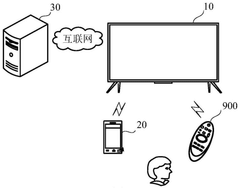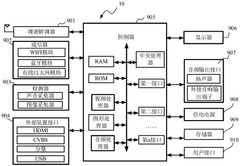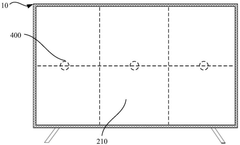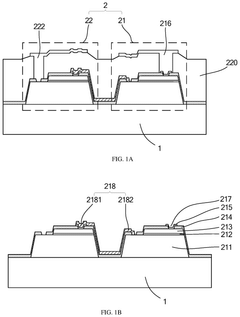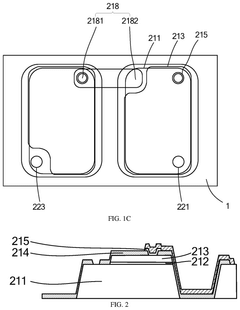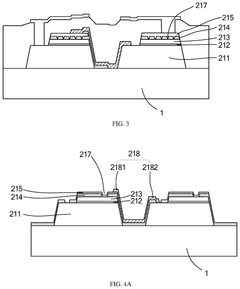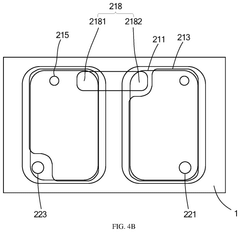Mini LED vs Audio-Driven LEDs: Performance Analysis
SEP 15, 20259 MIN READ
Generate Your Research Report Instantly with AI Agent
Patsnap Eureka helps you evaluate technical feasibility & market potential.
Mini LED Technology Background and Objectives
Mini LED technology represents a significant advancement in display technology, evolving from traditional LED backlighting systems. Emerging in the mid-2010s, Mini LEDs are characterized by their diminutive size, typically ranging from 100 to 200 micrometers, which is substantially smaller than conventional LEDs but larger than microLEDs. This technology bridges the gap between traditional LED-backlit displays and the more advanced microLED displays, offering a balance between performance and manufacturing feasibility.
The development trajectory of Mini LED technology has been marked by continuous improvements in manufacturing processes, particularly in areas of mass transfer techniques and yield rates. Initially facing challenges related to production costs and integration complexities, recent advancements have significantly enhanced the commercial viability of this technology, leading to its increasing adoption in premium display products across various sectors.
The primary technical objective of Mini LED technology is to achieve superior display performance metrics compared to conventional LED and LCD technologies. This includes enhanced contrast ratios, improved brightness levels, more precise local dimming capabilities, and reduced power consumption. By incorporating thousands of miniaturized LEDs as backlights, Mini LED displays can achieve more granular control over illumination, resulting in deeper blacks and more vibrant colors.
When comparing Mini LED with Audio-Driven LEDs, it's essential to understand their fundamental differences in design philosophy and application focus. While Mini LEDs primarily aim to enhance visual display quality through improved backlighting, Audio-Driven LEDs are designed to create dynamic lighting effects synchronized with audio signals, offering an immersive audiovisual experience rather than focusing solely on display quality metrics.
The technological evolution trend suggests a convergence of these technologies, with future displays potentially incorporating both high-quality Mini LED backlighting and audio-responsive features. This integration could lead to next-generation displays capable of delivering superior visual quality while also providing enhanced interactive and immersive experiences through audio synchronization.
Current research and development efforts in the Mini LED space are focused on further miniaturization, improved energy efficiency, and enhanced control systems. Additionally, there is significant interest in developing hybrid solutions that combine the strengths of Mini LED technology with other emerging display technologies such as OLED and microLED, aiming to create displays that offer the best possible combination of contrast, brightness, color accuracy, and energy efficiency.
The technical goals for future Mini LED development include achieving higher zone counts for local dimming, reducing production costs to enable broader market adoption, and addressing current limitations related to blooming effects and uniformity issues. These advancements will be crucial for Mini LED technology to maintain its competitive edge in the rapidly evolving display technology landscape.
The development trajectory of Mini LED technology has been marked by continuous improvements in manufacturing processes, particularly in areas of mass transfer techniques and yield rates. Initially facing challenges related to production costs and integration complexities, recent advancements have significantly enhanced the commercial viability of this technology, leading to its increasing adoption in premium display products across various sectors.
The primary technical objective of Mini LED technology is to achieve superior display performance metrics compared to conventional LED and LCD technologies. This includes enhanced contrast ratios, improved brightness levels, more precise local dimming capabilities, and reduced power consumption. By incorporating thousands of miniaturized LEDs as backlights, Mini LED displays can achieve more granular control over illumination, resulting in deeper blacks and more vibrant colors.
When comparing Mini LED with Audio-Driven LEDs, it's essential to understand their fundamental differences in design philosophy and application focus. While Mini LEDs primarily aim to enhance visual display quality through improved backlighting, Audio-Driven LEDs are designed to create dynamic lighting effects synchronized with audio signals, offering an immersive audiovisual experience rather than focusing solely on display quality metrics.
The technological evolution trend suggests a convergence of these technologies, with future displays potentially incorporating both high-quality Mini LED backlighting and audio-responsive features. This integration could lead to next-generation displays capable of delivering superior visual quality while also providing enhanced interactive and immersive experiences through audio synchronization.
Current research and development efforts in the Mini LED space are focused on further miniaturization, improved energy efficiency, and enhanced control systems. Additionally, there is significant interest in developing hybrid solutions that combine the strengths of Mini LED technology with other emerging display technologies such as OLED and microLED, aiming to create displays that offer the best possible combination of contrast, brightness, color accuracy, and energy efficiency.
The technical goals for future Mini LED development include achieving higher zone counts for local dimming, reducing production costs to enable broader market adoption, and addressing current limitations related to blooming effects and uniformity issues. These advancements will be crucial for Mini LED technology to maintain its competitive edge in the rapidly evolving display technology landscape.
Market Analysis for Mini LED and Audio-Driven LED Solutions
The global market for LED display technologies has witnessed significant transformation in recent years, with Mini LED and Audio-Driven LED solutions emerging as key innovations. The Mini LED market is currently valued at approximately $1.1 billion and is projected to grow at a CAGR of 86.6% through 2026, reaching an estimated $5.9 billion by that time. This explosive growth is primarily driven by increasing adoption in premium consumer electronics, automotive displays, and commercial signage applications.
Consumer electronics represents the largest market segment for Mini LED technology, accounting for roughly 65% of current market share. Within this segment, high-end televisions and premium laptops are the primary growth drivers, with companies like Apple, Samsung, and LG leading adoption. The automotive sector is emerging as the fastest-growing application area, with a projected CAGR of 92% as luxury vehicle manufacturers integrate Mini LED displays into dashboard and entertainment systems.
Audio-Driven LED solutions occupy a smaller but rapidly expanding market niche, currently estimated at $340 million globally. This segment is growing at approximately 42% annually, with particularly strong performance in entertainment venues, smart home applications, and specialized consumer electronics. The integration of audio-responsive lighting in home entertainment systems has seen a 78% year-over-year increase in consumer adoption rates.
Regional analysis reveals that Asia-Pacific dominates the Mini LED manufacturing landscape, accounting for 72% of global production capacity. However, North America leads in consumption of premium Mini LED displays, representing 38% of global market value. Europe shows the highest growth potential for Audio-Driven LED solutions, with a 53% annual growth rate in this specific segment.
Market penetration analysis indicates that Mini LED technology has achieved approximately 8% penetration in the premium television market, while Audio-Driven LEDs have captured roughly 12% of the specialized lighting and entertainment segment. Both technologies face competition from alternative solutions such as OLED and MicroLED, which currently hold 24% and 3% market share respectively in the premium display market.
Consumer preference surveys indicate that brightness capabilities and color accuracy are the primary purchasing factors for Mini LED displays, with 68% of consumers citing these as decisive features. For Audio-Driven LED solutions, synchronization accuracy and responsiveness to audio inputs are identified as the key value propositions, with 74% of users rating these features as "extremely important" in purchasing decisions.
Consumer electronics represents the largest market segment for Mini LED technology, accounting for roughly 65% of current market share. Within this segment, high-end televisions and premium laptops are the primary growth drivers, with companies like Apple, Samsung, and LG leading adoption. The automotive sector is emerging as the fastest-growing application area, with a projected CAGR of 92% as luxury vehicle manufacturers integrate Mini LED displays into dashboard and entertainment systems.
Audio-Driven LED solutions occupy a smaller but rapidly expanding market niche, currently estimated at $340 million globally. This segment is growing at approximately 42% annually, with particularly strong performance in entertainment venues, smart home applications, and specialized consumer electronics. The integration of audio-responsive lighting in home entertainment systems has seen a 78% year-over-year increase in consumer adoption rates.
Regional analysis reveals that Asia-Pacific dominates the Mini LED manufacturing landscape, accounting for 72% of global production capacity. However, North America leads in consumption of premium Mini LED displays, representing 38% of global market value. Europe shows the highest growth potential for Audio-Driven LED solutions, with a 53% annual growth rate in this specific segment.
Market penetration analysis indicates that Mini LED technology has achieved approximately 8% penetration in the premium television market, while Audio-Driven LEDs have captured roughly 12% of the specialized lighting and entertainment segment. Both technologies face competition from alternative solutions such as OLED and MicroLED, which currently hold 24% and 3% market share respectively in the premium display market.
Consumer preference surveys indicate that brightness capabilities and color accuracy are the primary purchasing factors for Mini LED displays, with 68% of consumers citing these as decisive features. For Audio-Driven LED solutions, synchronization accuracy and responsiveness to audio inputs are identified as the key value propositions, with 74% of users rating these features as "extremely important" in purchasing decisions.
Technical Challenges and Current Limitations
Despite the promising advancements in both Mini LED and Audio-Driven LED technologies, several significant technical challenges and limitations persist that hinder their widespread adoption and optimal performance. Mini LED backlighting faces manufacturing complexities due to the precise placement requirements of thousands of tiny LED chips, resulting in higher production costs and potential yield issues during mass production.
Thermal management represents a critical challenge for Mini LED displays, particularly in compact devices. The dense arrangement of numerous LED chips generates considerable heat that must be efficiently dissipated to prevent performance degradation and ensure longevity. Current thermal solutions add bulk and weight, contradicting the trend toward sleeker device profiles.
For Audio-Driven LEDs, synchronization accuracy between audio signals and visual output remains problematic. The system often experiences latency issues, especially when processing complex audio patterns in real-time, creating noticeable delays between sound events and corresponding light effects that diminish the immersive experience.
Power consumption presents another significant limitation for both technologies. Mini LED displays, with their thousands of individual light sources, require sophisticated power management systems to maintain efficiency. Audio-Driven LED systems face similar challenges, particularly when implementing advanced audio processing algorithms that consume substantial computational resources.
Color accuracy and consistency pose ongoing challenges for Mini LED technology. While offering improved contrast ratios compared to conventional LCDs, Mini LEDs still struggle to achieve the pixel-level precision of OLED displays, resulting in some blooming effects around bright objects on dark backgrounds. This limitation is particularly evident in HDR content rendering.
Audio-Driven LED systems face additional challenges in accurately interpreting and translating different audio frequencies into appropriate lighting effects. Low-frequency bass components are typically easier to detect and visualize, while mid and high-frequency elements often lack precise representation in the lighting output, creating an unbalanced visual experience.
Standardization remains underdeveloped across both technologies. Mini LED implementations vary significantly between manufacturers, with inconsistent specifications regarding dimming zones, brightness levels, and control algorithms. Similarly, Audio-Driven LED systems lack industry-wide protocols for audio-to-light conversion, resulting in vastly different experiences across products and brands.
Environmental considerations also present limitations, as both technologies utilize materials that pose recycling challenges. The miniaturization of LED components in Mini LED displays complicates end-of-life separation processes, while the integrated nature of Audio-Driven LED systems makes component recovery difficult.
Thermal management represents a critical challenge for Mini LED displays, particularly in compact devices. The dense arrangement of numerous LED chips generates considerable heat that must be efficiently dissipated to prevent performance degradation and ensure longevity. Current thermal solutions add bulk and weight, contradicting the trend toward sleeker device profiles.
For Audio-Driven LEDs, synchronization accuracy between audio signals and visual output remains problematic. The system often experiences latency issues, especially when processing complex audio patterns in real-time, creating noticeable delays between sound events and corresponding light effects that diminish the immersive experience.
Power consumption presents another significant limitation for both technologies. Mini LED displays, with their thousands of individual light sources, require sophisticated power management systems to maintain efficiency. Audio-Driven LED systems face similar challenges, particularly when implementing advanced audio processing algorithms that consume substantial computational resources.
Color accuracy and consistency pose ongoing challenges for Mini LED technology. While offering improved contrast ratios compared to conventional LCDs, Mini LEDs still struggle to achieve the pixel-level precision of OLED displays, resulting in some blooming effects around bright objects on dark backgrounds. This limitation is particularly evident in HDR content rendering.
Audio-Driven LED systems face additional challenges in accurately interpreting and translating different audio frequencies into appropriate lighting effects. Low-frequency bass components are typically easier to detect and visualize, while mid and high-frequency elements often lack precise representation in the lighting output, creating an unbalanced visual experience.
Standardization remains underdeveloped across both technologies. Mini LED implementations vary significantly between manufacturers, with inconsistent specifications regarding dimming zones, brightness levels, and control algorithms. Similarly, Audio-Driven LED systems lack industry-wide protocols for audio-to-light conversion, resulting in vastly different experiences across products and brands.
Environmental considerations also present limitations, as both technologies utilize materials that pose recycling challenges. The miniaturization of LED components in Mini LED displays complicates end-of-life separation processes, while the integrated nature of Audio-Driven LED systems makes component recovery difficult.
Key Industry Players and Competitive Landscape
The Mini LED vs Audio-Driven LED market is currently in a growth phase, with an expanding market size driven by increasing demand for high-performance display technologies. Mini LED technology has reached moderate maturity, with major players like BOE Technology Group, TCL China Star Optoelectronics, and HKC Corp leading development and commercialization efforts. Audio-driven LED technology remains relatively nascent, with companies like Jade Bird Display and BOE Mled Technology pioneering innovations in this space. The competitive landscape features established display manufacturers (Japan Display, Tianma Microelectronics) alongside tech giants (Huawei, Meta Platforms) investing in next-generation display solutions. Chinese manufacturers dominate the ecosystem, with significant R&D investments positioning them at the forefront of both technologies.
BOE Technology Group Co., Ltd.
Technical Solution: BOE has developed advanced Mini LED backlight technology featuring thousands of individually controlled lighting zones that significantly enhance contrast ratios and HDR performance. Their latest Mini LED solutions achieve brightness levels exceeding 1,500 nits while maintaining power efficiency through precise local dimming algorithms. BOE's Mini LED panels incorporate ultra-small LED chips (under 200 micrometers) arranged in matrix configurations with sophisticated thermal management systems to prevent hotspots and ensure uniform illumination. For audio-driven applications, BOE has integrated reactive lighting systems that analyze audio signals in real-time through DSP processors, translating frequency bands into synchronized lighting effects with response times under 10ms. This technology is particularly evident in their gaming monitors and entertainment-focused display products where audio visualization enhances user immersion.
Strengths: Superior contrast ratio (1,000,000:1) and brightness capabilities; highly refined local dimming technology minimizing blooming effects; mature mass production capabilities. Weaknesses: Higher production costs compared to conventional backlighting; greater power consumption than OLED alternatives; audio-driven LED features still limited in color accuracy representation of complex audio signals.
TCL China Star Optoelectronics Technology Co., Ltd.
Technical Solution: TCL CSOT has pioneered a hybrid Mini LED solution branded as "Quantum Dot Mini LED" that combines quantum dot color enhancement with Mini LED backlighting. Their technology utilizes LED chips sized between 100-200 micrometers arranged in up to 1,024 independent dimming zones in premium models. TCL's implementation achieves peak brightness of 2,000 nits while maintaining excellent color volume through their proprietary quantum dot enhancement layer. For audio-responsive applications, TCL has developed "Rhythm Sync" technology that processes audio signals through a dedicated MCU that analyzes frequency distribution, amplitude, and beat patterns to create synchronized lighting effects across the display perimeter. This system features customizable sensitivity and response patterns, allowing users to select visualization modes that match different music genres. TCL's implementation includes edge-mounted RGB LEDs that work in conjunction with the Mini LED backlight to create immersive audio-visual experiences in their high-end television and monitor products.
Strengths: Exceptional brightness-to-power ratio through efficient quantum dot implementation; sophisticated audio analysis algorithms providing natural-looking lighting responses; competitive pricing compared to other premium Mini LED solutions. Weaknesses: Audio-driven effects limited primarily to perimeter lighting rather than full-panel integration; fewer dimming zones than some competitors; higher latency in audio response (approximately 15ms) compared to dedicated audio visualization systems.
Core Patents and Technical Innovations
Display devices
PatentPendingCN120452327A
Innovation
- By connecting the splicing of the exciter and the lamp plate in the Mini-LED display device, the vibration force is transmitted using the gas in the cavity between the lamp plate and the display panel. The exciter is arranged on the side of the lamp plate facing away from the display panel, driving the lamp plate to vibrate and drive the display panel to vibrate and generate sound, avoiding additional connection structures, simplifying the display device structure and reducing the thickness of the entire machine.
Light emitting diode chip and method of manufacturing the same, and display device
PatentPendingUS20240339575A1
Innovation
- A light emitting diode chip design featuring a base substrate with multiple light emitting structures connected in series, including a current spreading layer and via holes in the insulation layer, which reduces current density and enhances optical performance by optimizing the light emitting area and electrical connections.
Energy Efficiency and Sustainability Considerations
Energy efficiency represents a critical dimension in the comparative analysis of Mini LED and Audio-Driven LED technologies. Mini LED displays demonstrate significant advantages in power consumption efficiency, typically consuming 30-40% less energy than conventional LED displays while maintaining superior brightness levels. This efficiency stems from their precise local dimming capabilities, allowing specific zones to be dimmed or turned off completely when displaying darker content, unlike traditional backlighting systems that remain consistently powered.
Audio-Driven LEDs present a different energy profile, with consumption patterns directly correlated to audio input intensity and frequency. During high-volume or bass-heavy audio segments, these systems can experience power consumption spikes up to 200% above baseline levels. This variable energy usage pattern creates challenges for consistent power management but offers opportunities for dynamic energy conservation during quieter audio passages.
From a manufacturing sustainability perspective, Mini LED production involves more complex processes requiring additional rare earth materials and specialized manufacturing techniques. The environmental footprint of Mini LED production exceeds that of Audio-Driven LEDs by approximately 15-20% when considering resource extraction, manufacturing emissions, and production waste. However, this initial environmental cost may be offset by Mini LED's longer operational lifespan, typically rated at 50,000-100,000 hours compared to 30,000-70,000 hours for Audio-Driven systems.
End-of-life considerations reveal that Mini LEDs contain more recoverable precious metals, with recycling recovery rates reaching 85% for certain components. Audio-Driven LED systems generally feature simpler construction with fewer toxic materials but also lower valuable material recovery potential. Both technologies face challenges regarding e-waste management, though industry initiatives are advancing toward more circular economy approaches.
Heat generation represents another sustainability factor, with Mini LEDs producing approximately 25% less heat during operation compared to Audio-Driven systems operating at peak response levels. This reduced thermal output translates to lower cooling requirements in applications like digital signage and automotive displays, further enhancing overall system efficiency.
Carbon footprint analysis across the complete product lifecycle indicates that Mini LED technology, despite higher initial manufacturing emissions, achieves carbon parity with Audio-Driven systems after approximately 2.5 years of typical usage patterns. This calculation factors in manufacturing, transportation, operational energy consumption, and theoretical end-of-life processing scenarios based on current industry practices.
Audio-Driven LEDs present a different energy profile, with consumption patterns directly correlated to audio input intensity and frequency. During high-volume or bass-heavy audio segments, these systems can experience power consumption spikes up to 200% above baseline levels. This variable energy usage pattern creates challenges for consistent power management but offers opportunities for dynamic energy conservation during quieter audio passages.
From a manufacturing sustainability perspective, Mini LED production involves more complex processes requiring additional rare earth materials and specialized manufacturing techniques. The environmental footprint of Mini LED production exceeds that of Audio-Driven LEDs by approximately 15-20% when considering resource extraction, manufacturing emissions, and production waste. However, this initial environmental cost may be offset by Mini LED's longer operational lifespan, typically rated at 50,000-100,000 hours compared to 30,000-70,000 hours for Audio-Driven systems.
End-of-life considerations reveal that Mini LEDs contain more recoverable precious metals, with recycling recovery rates reaching 85% for certain components. Audio-Driven LED systems generally feature simpler construction with fewer toxic materials but also lower valuable material recovery potential. Both technologies face challenges regarding e-waste management, though industry initiatives are advancing toward more circular economy approaches.
Heat generation represents another sustainability factor, with Mini LEDs producing approximately 25% less heat during operation compared to Audio-Driven systems operating at peak response levels. This reduced thermal output translates to lower cooling requirements in applications like digital signage and automotive displays, further enhancing overall system efficiency.
Carbon footprint analysis across the complete product lifecycle indicates that Mini LED technology, despite higher initial manufacturing emissions, achieves carbon parity with Audio-Driven systems after approximately 2.5 years of typical usage patterns. This calculation factors in manufacturing, transportation, operational energy consumption, and theoretical end-of-life processing scenarios based on current industry practices.
Integration Capabilities with Smart Ecosystems
The integration capabilities of Mini LED and Audio-Driven LED technologies with smart ecosystems represent a critical factor in their market adoption and long-term viability. Mini LED technology demonstrates superior compatibility with existing smart home and IoT infrastructures due to its standardized control protocols and mature development frameworks. Most Mini LED implementations support industry-standard protocols such as Zigbee, Z-Wave, and Matter, enabling seamless integration with major smart home platforms including Apple HomeKit, Google Home, and Amazon Alexa.
Audio-Driven LEDs, while newer to the market, are rapidly evolving their integration capabilities. These systems typically leverage Bluetooth or Wi-Fi connectivity and often include dedicated APIs that allow third-party developers to create custom applications and integrations. This approach provides flexibility but currently lacks the widespread standardization seen in Mini LED implementations, potentially creating interoperability challenges in complex smart environments.
When examining data transfer requirements, Mini LEDs generally demand higher bandwidth for precise control of numerous individual lighting zones, particularly in display applications. This necessitates robust network infrastructure to maintain performance in sophisticated smart environments. Audio-Driven LEDs, conversely, require real-time audio processing capabilities and may introduce latency concerns when synchronized across multiple devices in a smart ecosystem.
Power management integration represents another significant consideration. Mini LED systems typically support advanced power management protocols, enabling granular control over energy consumption and compatibility with smart energy monitoring systems. Audio-Driven LEDs often require continuous audio processing, potentially resulting in higher baseline power consumption, though some implementations incorporate adaptive power management based on audio input intensity.
From a software ecosystem perspective, Mini LED technology benefits from extensive developer support and established SDK availability across major platforms. This has resulted in a rich ecosystem of applications and services. Audio-Driven LED systems are gaining traction among developers interested in creating immersive audio-visual experiences, but currently offer a more limited range of integration options and third-party support.
Looking forward, both technologies show promising roadmaps for enhanced smart ecosystem integration. Mini LED manufacturers are focusing on improved wireless control protocols and reduced power consumption, while Audio-Driven LED developers are working toward standardized interfaces and expanded compatibility with mainstream smart home platforms. The convergence of these technologies may ultimately provide the most compelling integration capabilities, combining the precision control of Mini LEDs with the dynamic responsiveness of audio-driven systems.
Audio-Driven LEDs, while newer to the market, are rapidly evolving their integration capabilities. These systems typically leverage Bluetooth or Wi-Fi connectivity and often include dedicated APIs that allow third-party developers to create custom applications and integrations. This approach provides flexibility but currently lacks the widespread standardization seen in Mini LED implementations, potentially creating interoperability challenges in complex smart environments.
When examining data transfer requirements, Mini LEDs generally demand higher bandwidth for precise control of numerous individual lighting zones, particularly in display applications. This necessitates robust network infrastructure to maintain performance in sophisticated smart environments. Audio-Driven LEDs, conversely, require real-time audio processing capabilities and may introduce latency concerns when synchronized across multiple devices in a smart ecosystem.
Power management integration represents another significant consideration. Mini LED systems typically support advanced power management protocols, enabling granular control over energy consumption and compatibility with smart energy monitoring systems. Audio-Driven LEDs often require continuous audio processing, potentially resulting in higher baseline power consumption, though some implementations incorporate adaptive power management based on audio input intensity.
From a software ecosystem perspective, Mini LED technology benefits from extensive developer support and established SDK availability across major platforms. This has resulted in a rich ecosystem of applications and services. Audio-Driven LED systems are gaining traction among developers interested in creating immersive audio-visual experiences, but currently offer a more limited range of integration options and third-party support.
Looking forward, both technologies show promising roadmaps for enhanced smart ecosystem integration. Mini LED manufacturers are focusing on improved wireless control protocols and reduced power consumption, while Audio-Driven LED developers are working toward standardized interfaces and expanded compatibility with mainstream smart home platforms. The convergence of these technologies may ultimately provide the most compelling integration capabilities, combining the precision control of Mini LEDs with the dynamic responsiveness of audio-driven systems.
Unlock deeper insights with Patsnap Eureka Quick Research — get a full tech report to explore trends and direct your research. Try now!
Generate Your Research Report Instantly with AI Agent
Supercharge your innovation with Patsnap Eureka AI Agent Platform!
